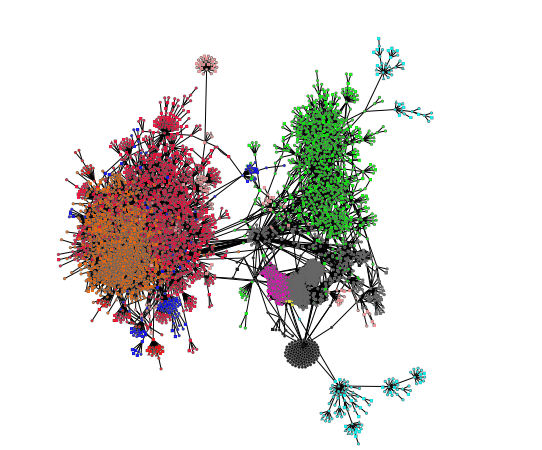Social Networks Reveal Structure (And Weaknesses) of Businesses
One of the unintended consequences of social networks is that they tend to reveal more about an individual than the information he or she has posted online. That’s because the structure of the network–the links set up between friends and acquaintances–is itself an important source of data.

For example, the principle that people are more likely to be friends with others who are like them immediately leads to a number of predictions that have been proven correct, such as the idea that if most of your friends have criminal records, you are more likely to have one too (or more likely to have one soon).
Today, Michael Fire and pals at Ben Gurion University in Israel take this idea a step further. These guys have used publicly available information on social networks to reconstruct the management structure of entire companies and to identify shortcomings in the way these companies operate.
The technique is straightforward. Fire and co begin by using a search engine to find the Facebook pages of a number of individuals who work for a specific company.
Using these individuals as seeds, they then begin crawling the social networks, sometimes jumping from one network to another, looking for other individuals at the same company. These in turn become seeds to find more employees and so on.
They end up with a basic network of links between employees within the company. It’s then that the fun begins.
Using standard measures of connectedness, Fire and co then identified people in positions of leadership and by adding in details such as location, mined from the Facebook pages, they reconstructed the international structure of these organisations. They also used community detection algorithms to reconstruct the organisational structure of the company.
Fire and co say they have tested these ideas on six well known hi-tech companies ranging from a small international hardware company with a few hundred employees to a large international technology corporation with over 50,000 employees.
The results reveal remarkable detail about the way these organisations are set up. For example, Fire and co found one group of employees at one company who were almost entirely disconnected from the rest of the organisation. By looking at these people’s publicly available employment histories, Fire and co worked out that they were all part of a start-up that had been bought by the company but had clearly failed to integrate into the broader organisation.
Clearly, Fire and co have a powerful business intelligence tool on the hands that will be useful for companies to better understand the nature of their organisation and how it is connected. These guys say that this understanding could be improved by comparing the social network data with the network of links set up between email correspondents. This kind of work has been done in the past for big organisations such as HP.
Of course, business intelligence has other potential users. For example, it’s not hard to imagine using this kind of approach to it to get a better understanding of a competitor’s business. Potential investors might also use it to find strengths and weaknesses in the way a business is run.
That raises the question of how companies can prevent this kind of information leaking out. “Organizations willing to conceal their structure, location and specialization of branches, identity of leaders, etc. must enforce strict policies which control the use of social media by their employees,” say Fire and co. That could put a few cats amongst the pigeons.
The bottom line of course is that the structure of social networks reveals far more than people intend about the way they live and work and the nature of society. This is yet another example.
Ref: arxiv.org/abs/1303.3741 :Organization Mining Using Online Social Networks
Keep Reading
Most Popular
Large language models can do jaw-dropping things. But nobody knows exactly why.
And that's a problem. Figuring it out is one of the biggest scientific puzzles of our time and a crucial step towards controlling more powerful future models.
The problem with plug-in hybrids? Their drivers.
Plug-in hybrids are often sold as a transition to EVs, but new data from Europe shows we’re still underestimating the emissions they produce.
Google DeepMind’s new generative model makes Super Mario–like games from scratch
Genie learns how to control games by watching hours and hours of video. It could help train next-gen robots too.
How scientists traced a mysterious covid case back to six toilets
When wastewater surveillance turns into a hunt for a single infected individual, the ethics get tricky.
Stay connected
Get the latest updates from
MIT Technology Review
Discover special offers, top stories, upcoming events, and more.